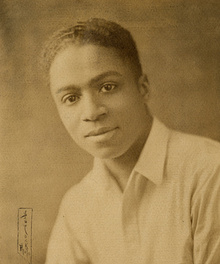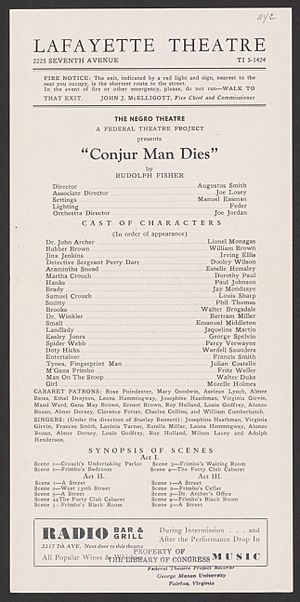Rudolph Fisher facts for kids
Quick facts for kids
Rudolph Fisher
|
|
|---|---|
 |
|
| Born | Rudolph John Chauncey Fisher May 9, 1897 Washington, D.C., United States |
| Died | December 26, 1934 (aged 37) New York, N.Y., United States |
| Occupation |
|
| Alma mater | Classical High School Howard University |
Rudolph John Chauncey Fisher (born May 9, 1897 – died December 26, 1934) was an American doctor, writer, and musician. He was a physician and a radiologist, which is a doctor who uses X-rays and other imaging to diagnose illnesses. Fisher also wrote novels and short stories, and was a playwright, musician, and orator (a public speaker).
His father, John Wesley Fisher, was a clergyman. His mother was Glendora Williamson Fisher. Rudolph had two siblings. In 1925, Fisher married Jane Ryder, a school teacher from Washington, D.C.. They had one son, Hugh, born in 1926. Hugh was sometimes called "The New Negro" as a nod to the Harlem Renaissance, a time of great artistic and cultural growth for Black people in Harlem.
Rudolph Fisher had a successful career as both a doctor and a writer. His stories often explored the relationships between Black and White people living in Harlem, a neighborhood in New York City. The challenges and connections between different races were a main topic in many of his works.
Contents
Growing Up and Education
Rudolph Fisher was born on May 9, 1897, in Washington, D.C. He grew up in Providence, Rhode Island. He was the youngest of three children. His father, Reverend John Wesley Fisher, was a Baptist pastor.
Fisher was a very bright student. He graduated with honors from Classical High School in 1915. He then went to Brown University, where he studied English and biology. He graduated from Brown in 1919 with a Bachelor of Arts degree. He was a top student and gave the main speech at his graduation. A year later, he earned his Master of Arts degree.
After Brown, Fisher gave his graduation speech, "The Emancipation of Science," at an event in Manhattan. He later went to medical school at Howard University in Washington D.C., graduating with honors in 1924.
On April 14, 1923, Fisher married Jane Ryder in Manhattan. She was a public school teacher. They had one son, Hugh Ryder Fisher (1926–1964).
In 1925, Fisher moved to New York City. He joined a special program at Columbia University's college. During this time, he published two scientific articles. His research was about treating Bacteriophage viruses using ultraviolet light.
Besides his medical and writing work, Fisher loved jazz music. He played the piano and wrote music. He even toured the East Coast as a band member with Paul Robeson after college.
Rudolph Fisher's Medical Work
In the 1920s, Fisher published his research on how ultraviolet rays affect viruses. He worked as a lead researcher at Manhattan's International Hospital. His medical experience helped him with his writing, especially for mystery stories. It also helped him describe the human body in his books.
In 1925, Fisher completed an internship at Freedman's Hospital. In 1926, he and his wife moved to New York. Fisher then joined a respected group called the Fellow at the National Research Council of the College of Physicians and Surgeons. Soon after, in 1927, Fisher became the superintendent of the International Hospital in Harlem. He also opened his own private practice as a radiologist in New York, with his own X-ray lab.
Rudolph Fisher's Writing Career
Fisher began his writing career by writing for magazines. One of these was The Crisis, published by the NAACP.
His first novel, "Walls of Jericho", came out in 1928. He was inspired to write it after a friend challenged him to write about both the rich and poor Black communities in Harlem. This novel showed that African American men and women could succeed if they worked together against unfairness.
In 1932, he wrote "The Conjure Man Dies". This was a very important book because it was the first detective novel to feature a Black detective. It was also the first detective novel with only Black characters, and it was set in Harlem. This book made him the second African American to write a detective novel in the United States.
Fisher also wrote several short stories:
- "City of Refuge" (1925), which appeared in Atlantic Monthly.
- "Vestiges", which appeared in Alain Locke's book of writings.
These two stories showed life and events during the Harlem Renaissance.
Fisher's last published work was the short story "Miss Cynthie" in 1933. It was about an older grandmother, Miss Cynthie, who traveled from the South to Harlem to meet her successful grandson. She was a hard-working and religious woman who had raised him. She expected him to be a respected professional. However, she found out his success came from being an entertainer in a theater, which she thought was a bad place. Even though she didn't like his job, she realized he had grown into an honest young man.
Other short stories by Rudolph Fisher include:
- High Yaller (1926)
- Blades of Steel (1927)
- Ringtail (1925)
- The South Still Lingers On
- Fire by Night
- The Promise Land
- The Caucasian Storms Harlem (1927)
- Common Meter (1930)
As writer Oliver Henry said, Fisher wrote about Black people in a way that showed they are similar to all other people. He highlighted the basic human experiences of Black Americans. He captured their unique qualities shaped by history, but most importantly, he wrote about them as people.
Interest in Pan-Africanism
Throughout his life, Fisher was interested in Pan-Africanism. This is a movement that started in 1900. Its goal is to encourage and strengthen the unity of all African-Americans and people of African descent worldwide.
Fisher supported the Pan-African Congress. People in this group believed that African countries should be free from colonial rule. They thought this freedom was needed for complete social, economic, and political equality. Unlike some other leaders like Malcolm X, Marcus Garvey, and W.E. B. DuBois, Fisher focused on the wider fight for fair labor rights for Black people and for women's empowerment.
Death
Rudolph Fisher died in 1934 when he was 37 years old. He passed away from abdominal cancer. It is believed this cancer was caused by his own experiments with X-rays. He was buried in Woodlawn Cemetery in The Bronx, New York City.
Main Works

- The City of Refuge (1925)
- High Yaller (1925)
- Ringtail (1925)
- The Caucasian Storms Harlem essay (1927)
- The Walls of Jericho (1928)
- The Conjure-Man Dies (1932)
- Miss Cynthie (1933)
Awards and Honors
- 1919: Brown Beta Kappa Key (an award for academic excellence)
- 1919: Brown University commencement speaker
- 1924: Honors from Howard Medical School
- 1925: The Crisis Spingarn Prize (for his writing)
- 1927: Brown University Class Day Orator (a speaker at a special event)
See also

